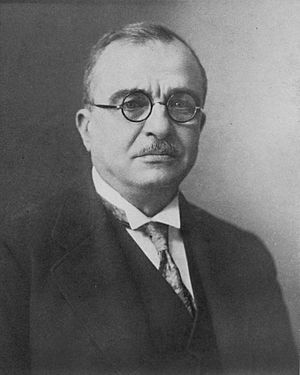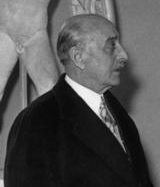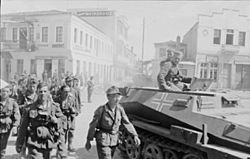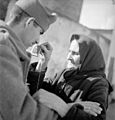Greco-Italian War facts for kids
Quick facts for kids Greco-Italian War |
|||||||
|---|---|---|---|---|---|---|---|
| Part of the Balkans campaign of World War II | |||||||
 Clockwise: Italian bombers over Greek territory, Italian soldiers during winter in Albania, Greek soldiers in Gjirokaster, Greek soldiers during the Italian Spring Offensive |
|||||||
|
|||||||
| Belligerents | |||||||
|
(air and material support) |
||||||
| Commanders and leaders | |||||||
(King of Italy) (Prime Minister of Italy) (C-in-C to 9 November) (C-in-C to mid-December) (C-in-C from mid-December) |
(King of Greece) (Prime Minister of Greece to 29 January 1941) (Prime Minister from 29 January to 18 April) (Prime Minister from 18 April to 23) (C-in-C) (Commander of RAF in Greece) |
||||||
| Strength | |||||||
| October: 6 divisions of 12 regiments 87,000 troops 463 aircraft 163 light tanks 686 artillery pieces November: 10 divisions of 20 regiments December: 17 divisions of 34 regiments January: 25 divisions of 50 regiments 272,463 troops 7,563 vehicles 32,871 animals April: 29 divisions of 58 regiments 400,000 troops 9,000 vehicles 50,000 animals |
October: 4 divisions of 12 regiments 50,000 troops 300 aircraft of which 160 operational(fighters) 940 artillery pieces 270 anti-aircraft 459.650 rifles 17,032 machine guns 315 mortar artillery 600 military vehicles November: 7 divisions of 21 regiments December: 13 divisions of 39 regiments January: 13 divisions of 39 regiments |
||||||
| Casualties and losses | |||||||
| 13,755 killed 50,874 wounded 3,914 missing 21,153 POW Total combat losses: 89,696 12,368 frostbite cases 52,108 sick 64 aircraft (another 24 claimed) 1 submarine 30,000 long tons of shipping General total: 102,064 |
13,325 killed 42,485 wounded 1,237 missing 1,531 POW Total combat losses: 58,578 ? sick c. 25,000 frostbite cases 52–77 aircraft 1 submarine General total: 83,578+ |
||||||
The Greco-Italian War was a conflict between Italy and Greece. It lasted from October 28, 1940, to April 23, 1941. This war was the start of the Balkans campaign during World War II. It involved the Axis powers (Italy, and later Germany) and the Allies (Greece, with British support).
In June 1940, Italy declared war on France and the United Kingdom. By September 1940, Italy had invaded parts of France, British Somaliland, and Egypt. Italy then started a negative campaign against Greece, saying Greece was helping Britain. Things got worse when an Italian submarine sank the Greek ship Elli on August 15. On October 28, Italy's leader, Benito Mussolini, demanded that Greece give up some land. The Greek Prime Minister, Ioannis Metaxas, said "no."
Italy invaded Greece from Italian-controlled Albania. However, the Italian army was not well-prepared. The Greek army, with help from Britain, fought back strongly. The mountainous and muddy land on the border also made it hard for the Italians. By mid-November, the Greeks had stopped the Italian invasion. They then pushed the Italians back into Albania. This advance included capturing the Klisura Pass in January 1941. This Greek success was called the "first Axis setback of the entire war."
The fighting slowed down in February 1941. Italy sent more soldiers to Albania, having 28 divisions against Greece's 14. In March, Italy tried another attack, but it failed. Both sides lost many soldiers, but Greece had fewer ways to replace its losses. They were also running low on supplies. Italian equipment was often poor, and their soldiers' morale was low.
Adolf Hitler of Germany decided that Britain's help to Greece was a threat. Germany began sending more troops to the Balkans. On April 6, Germany invaded northern Greece. Most Greek soldiers were fighting the Italians in Albania. This left the strong Metaxas Line in northern Greece with too few defenders. German forces quickly moved through Greece. The Greek army in Albania tried to retreat but was slow. Greece surrendered to Germany on April 20, 1941, and to Italy on April 23, 1941. Greece was then occupied by German, Italian, and Bulgarian troops.
Contents
Why the War Started
Italy's Ambitions in Europe
In the late 1920s, Italy's leader, Benito Mussolini, wanted Italy to expand. He believed Italy needed more "living space" for its people. He dreamed of an Italian empire stretching across the Mediterranean Sea.
Italy wanted to control countries in the Balkan region, like Albania and Greece. They also wanted to control parts of Yugoslavia. Mussolini's goal was to make Italy a major power in Europe.
In 1935, Italy invaded Ethiopia to expand its empire. In 1936, Italy sent many soldiers to help in the Spanish Civil War. These actions showed Italy's desire to become a strong military power.
In April 1939, Italy invaded and took over Albania. Albania was seen as a good place for Italy's growing population. It also gave Italy a base to expand further into the Balkans. In June 1940, Italy invaded France, and in September, they invaded Egypt.
Greece and Italy: Growing Tensions
Italy had taken the Dodecanese Islands from the Ottoman Empire in 1912. These islands had many Greek people. Italy had promised to give them to Greece but never did.
In 1923, an Italian general was killed on the border between Greece and Albania. Mussolini used this as an excuse to attack and temporarily occupy Corfu, a Greek island.
After 1923, Greece tried to keep peace with its neighbors. Greece also became closer to Britain. In 1928, Greece and Italy signed a friendship treaty. Mussolini hoped this would help him isolate Yugoslavia. However, Greece also made agreements with other Balkan countries, like Turkey and Yugoslavia. This created the Balkan Pact, which aimed to keep peace in the region.
When Italy started expanding again in 1935, Greece looked to Britain for protection. Britain had a strong influence in Greece, especially after King George II returned to power in 1935. Even when Ioannis Metaxas became dictator in 1936, Greece's foreign policy stayed linked to Britain.
Leading Up to the War: 1939–1940
In February 1939, Mussolini said that Greece was an "enemy of Italy and its expansion." After Italy invaded Albania in April, relations with Greece got much worse. Greece started preparing its defenses. Italy began improving roads in Albania to move troops more easily.
Italian newspapers started a campaign against Greece, saying it was a British puppet. Italian actions also caused tension. For example, Italian troops sang songs about taking Greek cities like Piraeus and Athens. Four of Italy's five divisions in Albania moved closer to the Greek border.
Britain and France publicly promised to protect Greece in April 1939. However, Britain did not want to make strong commitments. They hoped Mussolini would stay neutral in the coming war with Germany. Mussolini also told Metaxas that Italy would respect Greece's neutrality.
In May 1940, as Italy was about to enter World War II, the Italian press again attacked Greece. They accused Greece of allowing British warships in its waters. After France was defeated, tensions grew even more. Mussolini wanted Italy to conquer its "living space" before Germany won the war. He was frustrated that Germany did not want him to invade the Balkans.
On August 15, 1940, an Italian submarine sank the Greek ship Elli in Tinos harbor. This happened on a Greek national religious holiday. The attack angered the Greek people. Even though it was clear Italy was responsible, the Greek government said the submarine was of "unknown nationality" to avoid war. But no one was fooled. The attack made Greeks determined to fight back.

On October 7, German troops entered Romania. Mussolini saw this as Germany stepping into Italy's area of influence. He decided to invade Greece without telling Hitler. On October 13, Mussolini told his military chief, Marshal Pietro Badoglio, that Italy would go to war with Greece.
On October 28, 1940, Italy's ambassador in Athens gave Mussolini's demands to Metaxas. Italy wanted to occupy important points in Greece. Metaxas rejected the ultimatum with the words "Then it is war." The Greek people also showed their will to resist with the word "ochi" (Όχι), meaning "no." Within hours, Italy attacked Greece from Albania.
War Plans and Forces
Italy's Invasion Plan
Italy wanted to create a Greek puppet state. They planned to take Greek islands like the Ionian Islands and the Sporades. They also wanted to annex parts of mainland Greece, like the Epirus region.
Mussolini decided on war on October 13. The plan was to capture Epirus. Italian generals, like Marshal Badoglio, thought conquering all of Greece would need more soldiers and time. However, Mussolini insisted on attacking quickly.
The Italian commander, Lieutenant-General Sebastiano Visconti Prasca, was very confident. He believed he could defeat the Greek forces in Epirus in ten to fifteen days. He wanted to capture Athens and become famous.
The front was about 150 kilometers wide, mostly in mountains with few roads. The Pindus mountains divided the area into two parts: Epirus in the west and western Macedonia in the east. Italy divided its forces accordingly.
Italy had about 87,000 soldiers for the invasion. They also had 463 aircraft and 163 light tanks. However, many of these tanks were not ready for battle.
Greece's Defense Plan

In 1936, Greece's leader, Ioannis Metaxas, started to prepare the Greek military. They built the "Metaxas Line" of defenses along the border with Bulgaria. They also bought new equipment for the army.
After Italy took Albania in 1939, Greece prepared for a possible attack from both Italy and Bulgaria. Their plan was to fight defensively and slowly retreat to stronger lines.
The Greek army in Epirus, led by Major-General Charalambos Katsimitros, decided to defend closer to the border. He chose the Kalpaki line, which was good for defense and used the Kalamas river swamps to stop Italian tanks.
Greece's main concern was Bulgaria, so most of its defenses were in the north-east. However, when Italy attacked, Greece quickly moved its forces to the Albanian front.
On October 28, the Greek army had about 260,000 soldiers. They had 14 infantry divisions and one cavalry division. Most of their equipment was from World War I. The Royal Hellenic Air Force had about 100 aircraft, which were fewer and older than Italy's. The Royal Hellenic Navy was also much smaller than the Italian navy.
Despite the Italian military's size, the Greek people were very determined to fight. They were angry about the sinking of the Elli and ready to resist.
The War Unfolds
The Greco-Italian War had three main parts:
- The Italian attack and its defeat (October 28 – November 13, 1940).
- The Greek counter-attack (November 14, 1940 – January 6, 1941).
- The front becoming stable until Germany attacked (January 6 – April 6, 1941).
Italian Invasion and Greek Resistance (October–November 1940)
Italian forces invaded Greece in several groups. On the coast, they moved towards Igoumenitsa and Preveza. In the center, they aimed for Ioannina. In the Pindus mountains, the Italian Julia Division tried to cut off Greek forces by capturing Metsovo.
The Greek commander, Alexandros Papagos, was put in charge of all Greek forces. Because Bulgaria stayed neutral, Greece could send most of its army to fight the Italians in Albania.
Fighting in Epirus
In Epirus, General Katsimitros used a strong defensive line at Kalpaki. The Kalamas river and its swamps made it hard for Italian tanks to advance. On November 1, the Italians captured Konitsa.
The main Italian attack on Kalpaki began on November 2. An attack with 50-60 tanks was stopped by the Greeks. By November 8, the Italians started to pull back. They needed more soldiers.
On November 8, General Ubaldo Soddu took over command of the Italian forces in Albania. He reported that Greek resistance was strong. Mussolini agreed to let the Italians defend their positions. By November 13, Greek forces had pushed the Italians back to the Kalamas river.
The Battle of Pindus
The Italian Julia Division tried to cross the Pindus Mountains. This threatened to cut off Greek forces. The Greek Pindus Detachment, with only 2,000 men, faced this attack. The Italian attack was fast, but the Greeks fought hard.
Despite heavy snowfall, the Julia Division reached Vovousa on November 2. But they could not reach their main target, Metsovo. The Greeks surrounded the Italian spearhead on November 3. Local civilians helped the Greek forces a lot. The Julia Division was almost destroyed. By November 13, the Greeks had taken back the Grammos and Smolikas mountains.
Greek Counter-Attack (November 1940 – January 1941)
By November 14, Italy had reorganized its forces in Albania. But their situation was difficult. Their soldiers were tired, and supplies were low. Albania's ports were too small to handle all the supplies and new soldiers needed.
The Greek army had over 100 infantry battalions. They were fighting on land they knew well.
Taking Korçë
The Greek III Corps started attacking Albanian territory in early November. Their main goal was to capture the Korçë plateau, which controlled access to Albania. The Greeks attacked on November 14 without an artillery barrage to surprise the Italians.
The Italians were indeed surprised. The Greeks broke through their lines. On November 18, some Greek soldiers panicked, but the new commander stopped any retreat. On November 19-21, the Greeks captured the Morava mountain. Fearing being surrounded, the Italians retreated. On November 22, the city of Korçë was captured by the Greek 9th Division.
By November 27, the Greeks had taken the entire Korçë plateau. They had also pushed the Italians out of Greek territory by November 23.
Pushing Towards Valona
After taking Korçë, the Greek command decided to push towards the port of Valona. Capturing Valona would be very important because it would leave Italy with only one main port in Albania.
The Greek I Corps moved north along the Gjirokastër–Tepelenë–Valona route. The Greek II Corps would connect the I Corps with the forces in western Macedonia.
The Greek advance continued. On December 5, I Corps captured Delvinë. On December 8, they took Gjirokastër. The Greeks also captured Himarë on December 22. The Greek II Corps got close to the strategic Klisura Pass but could not capture it yet.
The continued Greek success caused problems for Italy. Mussolini even thought about asking for a truce. On December 4, Mussolini replaced his military chief, Badoglio, with Ugo Cavallero.
Stalemate and German Intervention (January–April 1941)
By December 28, 1940, the Greek army decided to stop large attacks. Italian resistance was stronger, supplies were getting low, and the bad weather caused many injuries from frostbite. This decision took effect on January 6.
Italy had many more divisions in Albania by this time. Cavallero started planning an attack to take back Korçë.
Battle for Klisura Pass
The main Greek goal was to capture the Klisura Pass. The Greek II Corps attacked on January 8. After hard fighting, they captured the pass on January 9. This forced Cavallero to use his reserve troops.
The newly arrived Italian Lupi di Toscana division was badly defeated. By January 16, this division had almost completely fallen apart. On January 26, the Italians tried to take back the pass but failed. The Greeks then counter-attacked and captured the Trebeshinë massif in February. The capture of Klisura Pass was a big success for the Allies.
As the threat of a German invasion grew, Greece tried one last push to capture Valona quickly. The British Air Force helped by fighting Italian planes. However, Italian resistance and bad weather stopped the Greek advance before they reached Valona.
By early February 1941, the Greek army had very little artillery ammunition left. They were also short on other supplies and even food. The British sent some aid, but it was not enough.
On March 4, Britain sent more troops and supplies to Greece. Italy wanted to win a victory before Germany intervened. They launched a big attack on March 9. Mussolini himself watched the attack. The Italian attack began with heavy artillery and air bombing. However, the Greek defenses held strong. All Italian attacks failed. The Italian offensive stopped on March 24 without any success. Mussolini admitted the result was "zero."
The Italian attack showed how short Greece was on weapons and equipment. Even with British help, Greece was running out of supplies. The Greek defenses in Macedonia, which would face the Germans, were weak because so many soldiers were in Albania.
Italian generals asked Germany for help. Meanwhile, Greek, British, and Yugoslav officers planned a joint attack to push the Italians out of Albania. But it was too late.
German Invasion of Greece
On April 6, Germany invaded northern Greece through Bulgaria. This created a second front for Greece. Greece had received some British help, but no more was sent after the invasion began. The Greek army was outnumbered. The German forces quickly broke through the Greek defenses.
The British forces began to retreat. Allied troops held the Germans at Thermopylae for a few days, allowing ships to evacuate British soldiers. The Germans reached Athens on April 27. The conquest of Greece was finished when Crete was captured a month later. Greece was then occupied by German, Italian, and Bulgarian forces until late 1944.
On April 12, the Greek command ordered its forces in Albania to retreat. But it was too late. The Greek commanders knew that retreating would be very difficult. The soldiers were exhausted, and there were not enough vehicles or animals to carry supplies.
By April 15, some Greek divisions began to fall apart. Soldiers started leaving their positions. On April 16, General Ioannis Pitsikas reported that his army was breaking down. He asked to surrender to the Germans to save the army. On April 20, General Georgios Tsolakoglou signed a surrender agreement with the Germans.
War at Sea and in the Air
The Greek navy was much smaller and older than the Italian navy. Its main job was to patrol and escort supply ships. This was very important because Greece's land transport was poor. The Greek navy moved about 80,000 soldiers and 100,000 animals by sea during the war.
Greek submarines sank some Italian transport ships. However, the Greek submarine force was too small to stop Italy's supply lines to Albania. Italian ships made thousands of trips across the Strait of Otranto, carrying hundreds of thousands of soldiers and tons of supplies.
The British Royal Navy also fought the Italian navy. On November 11-12, 1940, the British attacked the Italian fleet at Taranto. They damaged half of Italy's main warships. On March 28, 1941, the British intercepted the Italian fleet at the Battle of Cape Matapan. They sank three Italian cruisers and two destroyers. This was a major defeat for the Italian navy.
Air Battles
Italian Air Force
The Italian Air Force had trouble operating from Albania. The airfields were poor, especially in bad weather. There was also a lack of cooperation between the Italian air force, navy, and army.
On October 30, the first air battle happened. Italian fighters shot down two Greek planes.
Greek Air Force
On November 2, a Greek pilot named Marinos Mitralexis shot down an Italian bomber. When he ran out of ammunition, he used his plane's nose to smash the tail of another bomber, sending it out of control. This act boosted Greek morale.
British Royal Air Force (RAF)
The British RAF helped Greece. They used secret messages to know Italian bombing targets. From mid-November to December, British bombers attacked Italian ports and airfields. British fighters helped reduce Italian air raids. By the end of 1940, British Gladiator fighters had shot down many Italian planes.
The British fighters largely stopped Italian air operations after mid-February. By April, the RAF had claimed many Italian aircraft shot down.
Life During the War
In Greece
The war made the Greek people very enthusiastic. Crowds filled the streets, and newspapers published patriotic stories. The story that Metaxas bravely said "ochi!" ("no!") to Mussolini made him a national hero.
Men rushed to volunteer for the war. Soldiers had high morale and felt strongly that Greece had to fight. Even many Greeks who did not like Metaxas supported him during the war.
Greek artists wrote patriotic songs. The singer Sofia Vembo became a folk hero. Her patriotic and funny songs inspired soldiers and people.
In Italy
The Italian public was not very excited about the war at first. When the Italian attack failed, people became unhappy. They started calling the war "a second and worse Caporetto," referring to a big Italian defeat in World War I.
The government's popularity dropped when strict food rationing started in December. Prices also went up. Mussolini tried to boost morale by sending high-ranking Fascist officials to the front.
In Albania
Italy tried to get Albanians to support their rule. They promised to help Albania gain land. However, Albanian support for the war was low. Albanian soldiers fighting with Italy often left or ran away.
Some Albanians helped the Greeks, especially the local Greek populations. Greece said they were fighting to free Albania, but their claims on Northern Epirus made Albanians suspicious. The Greek army followed international laws and did not harm civilians or their property.
What Happened After
War Losses
The Italian army started with about 87,000 men and grew to about 565,000. Italy lost about 13,755 soldiers killed, 50,874 wounded, and 25,067 missing or captured. Many also suffered from frostbite and sickness. The Italian Air Force lost 79 aircraft.
The Greek army had fewer than 260,000 men. Greece lost about 13,325 soldiers killed, 42,485 wounded, and 1,237 missing. About 25,000 suffered from frostbite. The Greek Air Force lost between 52 and 77 aircraft.
In 2018, Greece and Albania agreed to find and properly bury the bodies of Greek soldiers who died in the war. Many had been buried quickly after their deaths.
Occupation of Greece
After the German invasion, Greece was divided and occupied. Italy took most of the mainland. German forces occupied Athens, Thessaloniki, and some islands. Bulgaria, which had not fought in the invasion, occupied parts of northern Greece. Italian troops took over their zone of occupation from April 28 to June 12.
Images for kids
-
Ambitions of Fascist Italy in Europe in 1936.
-
Eleftherios Venizelos, Prime Minister of Greece (various terms 1910–1933)
-
Benito Mussolini, Prime Minister of Italy
-
Marshal Pietro Badoglio, Chief of Staff of the Italian military since 1925
-
Meeting of the Anglo-Greek War Council ca. January 1941. Left to right: Major General Michael Gambier-Parry, Dictator Ioannis Metaxas, King George II of Greece, Air Vice Marshal John D'Albiac (RAF) and General Alexandros Papagos.
-
Bristol Blenheim bomber of No. 211 Squadron RAF at Menidi, Greece



















